Al-Hawdaj; The Sudanese Camel Litter

Above, the richly tasseled, cowrie-encrusted trappings of a western Sudanese howdaj, Sudan Ethnographic Museum, Khartoum, photograph, Imogen Thurbon.
The Hawdaj, also known as JaHfa or ‘uTfa in classical Arabic, is a camel-borne litter crafted, assembled and adorned by Sudanese women. It is reserved for the exclusive use of women and children and plays a central role in seasonal migrations of the nomadic camel herding peoples, abbāla, of both western and eastern Sudan. The term shibriya, sometimes used to denote the wooden framework of the canopy, is also used to refer to the litter as a whole and in particular to that used by female elders. The excerpt below is taken from Hamid Dirar’s gripping memoir of a nomad childhood among the Shukriya people; The Amulet.
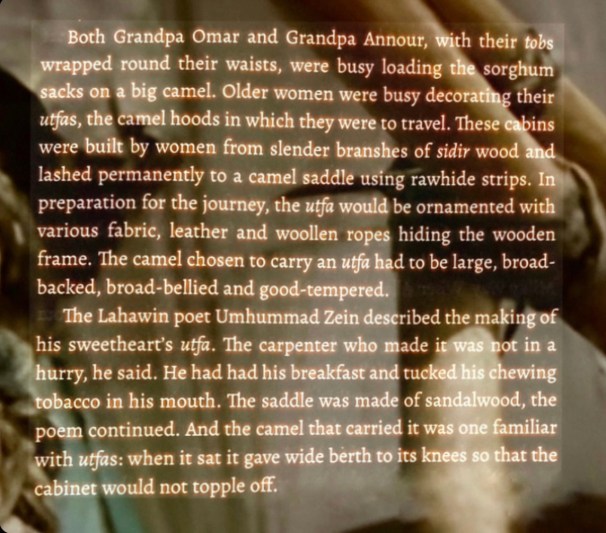
*The sidir referenced above is the jujube tree. Other sources note that shaHiiT wood is also used.
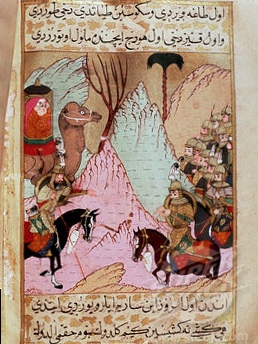
The ‘uTfa and its rich symbolism is deeply embedded in Arab culture, where it is associated not only with practical solutions to the challenges of seasonal migration, but also with hunting, war, tribal status, wealth and nobility. A most ornately decorated ‘uTfa bearing the daughter of a tribal leader at war would serve as standard and inspiration for his warriors as they went into battle. The camel bearing the ‘uTfa might be captured by his enemies but the rider would be returned, her honour intact, to her family. Historical accounts relate famous incidences of early heroines of Islam leading armies into battle from an ‘uTfa, such as in the Battle of the Camel. For orientalists, the ‘uTfa would offer tantalizing echoes of tabernacles and The Arc of the Covenant (see below).

“During the feuds between the Shukriya and Batahin of the Sudan, the Shukriya were led by a woman Sagharab against the Batahin …..(circa 1804). In the Wahaby campaigns of Muhammad Aly Pasha, his brother-in-law, Mustafa Bey was defeated by Azila, who led her tribe against him in an utfa. She had the feet of her camel tied so that it could not be moved…..during the invasion of Sudan by the army of Ismail Pasha in 1820, Safia, the daughter of Mek Zubeyr of the Hannekab Shaigia, was captured by the Turks at the battle of Dagu when seated on an utfa during the battle.” (The “Utfa or Camel-Litter of the Arabs, Royal African Society, African Affairs, Volume XXX, Issue CXVIII, January, 1931) Left, the ceremonial, passenger-less litter or mahmal, Cairo, 1867-76, CC
Below, the wooden framewood of the hawdaj, ready to be draped and adorned by Sennar nomad women. The wooden rungs that form the roof of the litter are known as the sirīr and the cloth, often white or brightly coloured which is secured tent-like over it is the barāqa, still from ياهودة السودان حياة البدو تربة الابل والهودج,
This video is embedded at the end of this post.

“We rode into a family of Arabs of the Mahamid section of the Rizayqat. I will never forget the sight which met my eyes as the Arabs came towards us. There was a small herd of camels being marshalled by some oldish men on horses, but the herd was led by a gigantic male camel, carrying on its back a black litter. This was almost like a small house or shelter, built on a special frame, which fitted over the saddle. The frame was draped with skins and cloth and around it were attached all kinds of baskets, leather, and wooden vessels, which represented all the nomads’ worldly possessions. The camel was decorated with a headdress of jet-black ostrich feathers, and a variety of plaited leather necklaces, from which streams of hide cascaded, decorating its head and neck. More ornate streamers tumbled from special saddlebags at the animal’s flanks, Within the depths of the litter, known in Arabic as the howdaj, I could make out the thin pale face of a woman.”
Michael Asher, explorer and ecologist, writing in the 1980s, In Search of the Forty Days’ Road

Above, still from ياهودة السودان حياة البدو تربة الابل والهودج,
Al-Hawdaj; The Sudanese Camel Litter

Setting the Scene
Honouring Women On the Move Adornments
Colonial Accounts

Setting the Scene
الراقب الشبرية بالله حن عليا بفارق المدينة وبتابع السعية
Above, a line from just one of the many popular songs and poems celebrating the beauty of the hawdaj and the woman enthroned within. Here a would-be suitor implores the maiden concealed in the glowing drapery of the litter; “oh rider of the shibriya, I call on God that you might have mercy on me (for) I am departing the city in the tracks of my herds (literally, following my livestock).

Title image and above, sketch based on a still from ياهودة السودان حياة البدو تربة الابل والهود This beautifully filmed, nine-minute report provides a rare chance to watch the assembling of the howdaj by nomad women of Dinder. A transcription of the text will be available shortly. The wedding hawdaj is perhaps among the most spectacular of Sudanese nomad artifacts.
Below, a two-minute celebration of the wedding hawdaj among the Ziyaadiya of western Sudan (un-narrated).
Below, an ‘uTfa exhibited at Burri Gardens, Khartoum, 2019.

This week’s article draws on contemporary Arabic media, as well as western accounts of the Sudanese hawdaj; a source of fascination to non-nomadic Sudanese and colonialists alike. I reproduce below extracts from Seligman’s evocative and meticulously detailed Sacred Litters Among the Semites with Reference to the Ufta of the Kababish, Sudan Notes and Records, Volume 1, 1918. It is important to note that corrections to Seligman’s text and its Arabic terms were offered by other colonial observers and can be found in SNR.
I would very much welcome any corrections to my text and apologize in advance for any inaccuracies in the terms or customs outlined below.
Scroll down to the end of this post for some of the sources used in this article.

Above, stills from as-Sudan TV and Aljazeera FB. Top left, the woman in the saffron toub holds plaited skeins of four leather thong tassels, topped with red cloth embroidered with cowrie shells. These are known as ايدين الفايقة; iiydiin al-faaiiga. Top right, examples of the conical camel headdress known as gumbūr. Immediately below it, after hanging the shamla or woven hair cloth over the canopy hood, the woman secures the baraaqa, tent-like drapes.
Below, eastern Sudanese howdaj in profile, Sudan Ethnographic Museum.


Al-Hawdaj; The Sudanese Camel Litter
Honouring Women On the Move Adornments
Colonial Accounts

Above, stunnng resonances of the hawdaj, Tariq Nasre, Instagram

Honouring Women on the Move
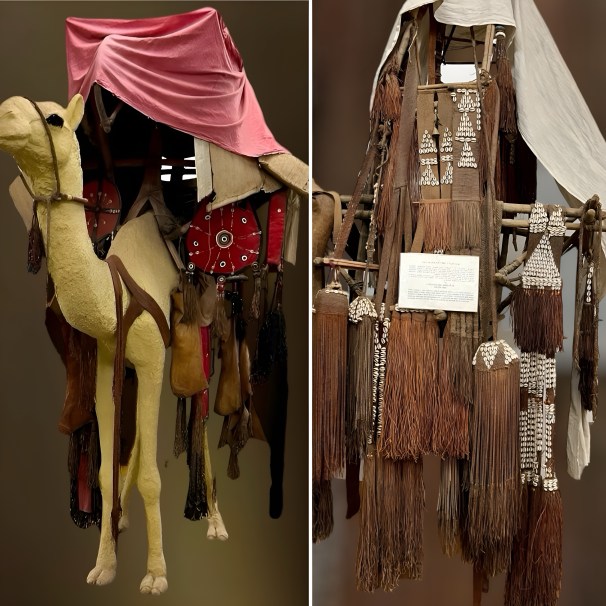
Above, the distinct hawdaj esthetics of eastern (left) and western Sudan, Sudan Ethnographic Museum, Khartoum.

Bedecked with hand-woven cloths, ribbons, finely worked skins, and at its most ornate, tiny embroidered mirrors, silver beading and precious stones glinting in the desert sun, the howdaj is seen by many as a graceful and very necessary tribute to nomadic women. “The hawdaj is a way of giving something back to women in appreciation for all they do; they are the rural workforce and the ones who raise our children”, one researcher explained, going on to say the new bride, resplendent in a shibriya draped in vibrant colours “represents our esteem and respect” as she is gently cradled by a camel chosen for its stately gait and steadiness.
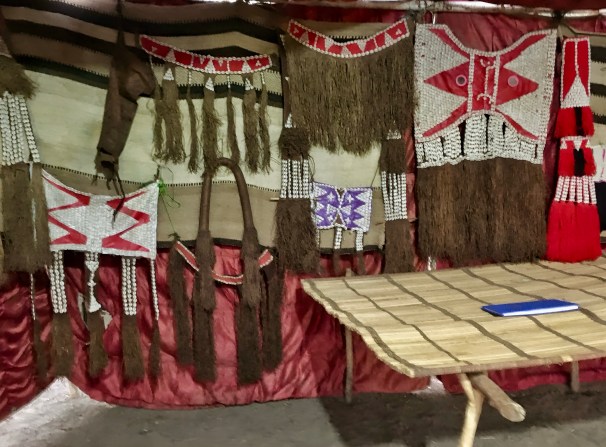
The howdaj expresses “reverence for the bride”, another Sudanese researcher notes, and among the Kababish, songs are sung to those decorating the camels. The bridal ‘uTfa is a striking and tangible celebration of the status and wealth of the families to be wed and its decoration a lively competitive feat of artistic skill. The wedding ‘uTfa often bears tinkling bells to distinguish the bridal procession as it makes its way from the bride’s family to her marital home. The bridal camel is also laden with her possessions and all the home-making equipment she will need for her new life.
“In Sudan this tola /dola (ceremonial ‘uTfa with a raised cradle-like seat) is sometimes a personal possession and was frequently given to a girl by her father or brother upon her attainment of the marriageable age. There is considerable rivalry among the possessors of these utfa in regard to the splendour and costliness of the fittings…”
The Utfa or Camel-litter of the Arabs
Right when not in use, the hawdaj adornments serve to decorate the nomad home, photo, exhibition of Sudanese culture and crafts, Burri Gardens, Khartoum, 2019.

Pinterest; the workaday howdaj.
When not decked out in wedding finery, the hawdaj‘s humbler but vital role is to protect women and children on their seasonal migrations from the harsh summer sun, winter cold, rain and, experts remind us, from envious and indiscreet eyes and improper attention. Its rigging allows for the carrying of coffee and cooking utensils, water skins, milk skins, gourds used for churning milk and fermenting yoghurt; and foodstuffs, such as flour, sugar and sorghum sufficient for long journeys. Even the traditional wooden rope bed, the ‘angareeb can be taken apart and borne by the ‘uTfa camel.
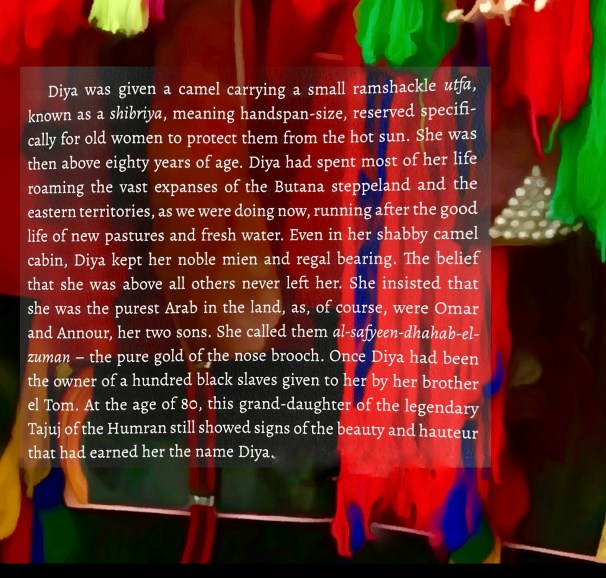
Above, Hamid Dirar’s account of his redoubtable grandmother, Diya, on her shibriya.

Adornments
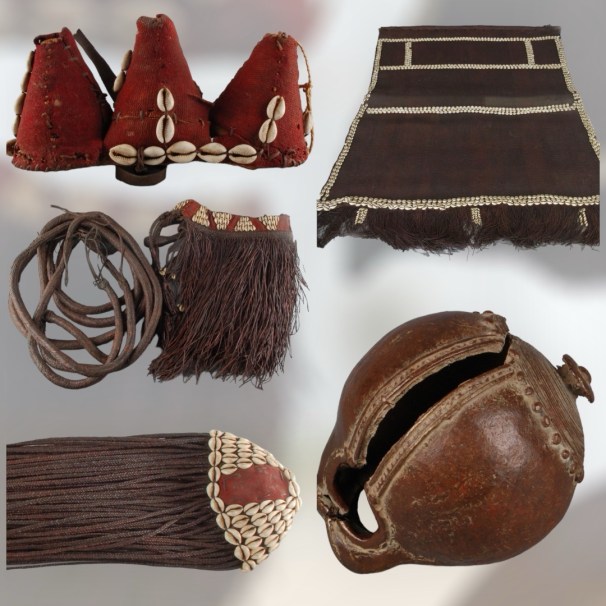
Above, camel trappings, some from Kordofan, in the collection of The British Museum. Photographs, CC.
Top left, composite head ornament for a camel:- three coiled basketwork cones of vegetable fibre, covered with red cloth and ornamented with cowries, attached with leather straps, top right, leather throngs woven into a large sheet, one end of which is sewn round a sandalwood stick, with the other end composed of a fringe of unplaited thongs. Middle left, a branded leather camel halter. Bottom left, a composite tassel, made of plaited leather thongs, ornamented with cowries with triangles of red velvet. Bottom right. a cast bronze Indian cattle bell, purchased from the neck of a Tuareg camel in western Sudan.
Below, examples of camel adornments from the collection of the Sudan Ethnographic Museum, Khartoum.

Below, a glossary of camel trappings terms, from Some Notes on the Tribes of the White Nile Province, Sudan Notes and Records, Volume 13, 1930.

Below, Sudan Ethnographic Museum.
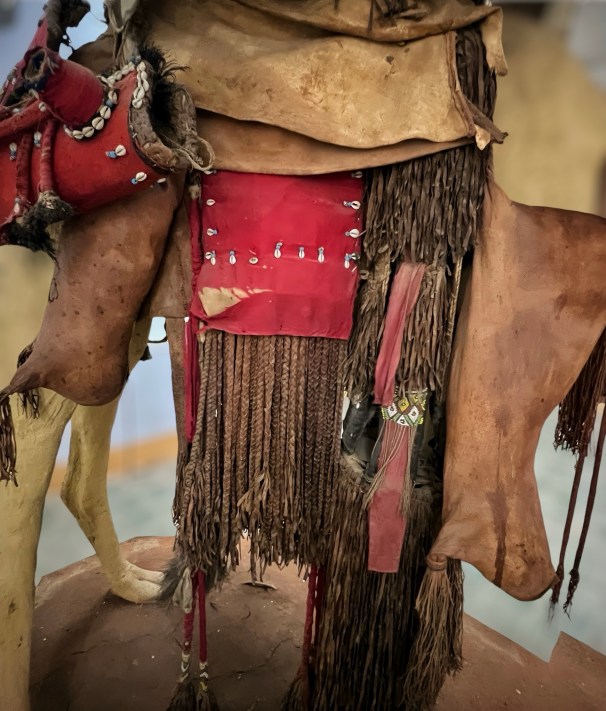
Below, detail of the iiydiin al-faaiiga.


Colonial Accounts
“He leaves his cultivation placing on his camel a canopied angarib whereupon sits his wife with the younger children by her side. He hangs about the trappings heads of sugar, skins of water and bags of dates, till the appearance of the camel resembled that of a moving Christmas tree with the surprise packet carefully hidden on top. The older boys drive the goats and so the Arab and his family journey to the cool of the hills and leave Tokar and its cotton merchants….
Sudan Notes and Records, Volume 3, 1920.
” To procure good rains the Bisharin sometimes set up a gaily caparisoned utfa at which the men gallop on their camels, circling it at speed while the women give voice to their ear-splitting zagharit.
SNR, Volume 21, 1938 .
Below, an excerpt from Sacred Litters among the Semites with Reference to the Utfa of the Kababish. I reproduce only sections of the text relating to the Sudanese ‘uTfa but the article includes fascinating details of ‘uTfas throughout the Arab world. This article is made available by Sudan Open Archive, an invaluable public resource.

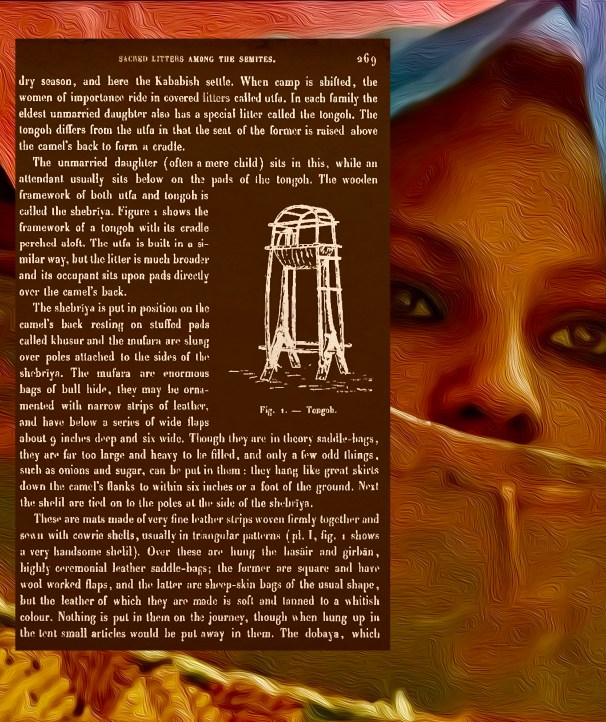

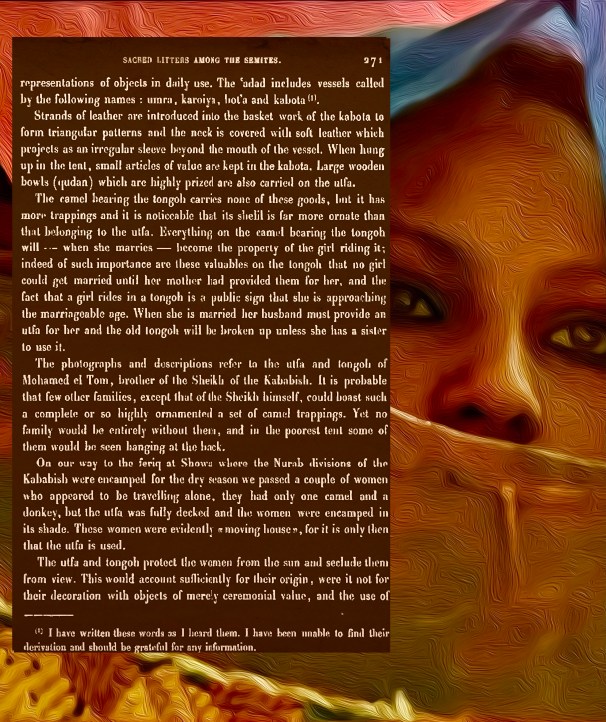


Selected Sources
“الشبرية”… منزل سوداني على ظهور الإبل
“الهودج”.. لرحلات تنقل بدو السودان
هودج قبيلة الرزيقات بغرب السودان يرفرفامام الجماهير من الشعب السوداني وحكومته بحضور رئيسالجمهورية
الهودج”.. لرحلات تنقل بدو السودان
The “Utfa or Camel-Litter of the Arabs, Royal African Society, African Affairs, Volume XXX, Issue CXVIII, January, 1931
Palanquins on Camels and elephants in the Islamic World



Fascinating and learned
LikeLike